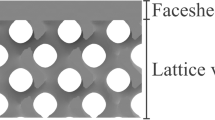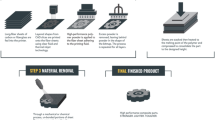Abstract
Composite materials are currently in high demand because of their unique properties, such as high stiffness, light weight, and distinctive appearance. A composite material composed of fibers and a resin can be manufactured through a variety of methods. One such method typically used for low production volume and custom applications is the hand layup method, which involves manually combining fibers and resin on a mold surface. For large quantity manufacturing and production of composites, molds are typically made out of a highly durable material like aluminum or steel. The initial investment of the mold is recovered through the manufacturing of numerous parts. However, in low volume and one-off productions, molds are typically handmade by a composite technician, which increases the cost to manufacture a part. The objective of this project was to use large area additive manufacturing, commonly known as 3-D printing, to create molds for these small scale production runs and assess the ability to use them for hand layup composites. After printing, some molds were treated with various surface coatings, and others were machined by a CNC mill. The finished molds were used for hand laying of fiberglass parts in order to assess the durability and resulting surface quality. It was found that printed molds could be an effective approach for limited production runs (4–5) of fiber reinforced composite parts, depending upon the mold shape, surface finish, and coating composition.
Similar content being viewed by others
References
Claunch, E (2015) Forecasting on composites—markets, products, and demands. Journal of Textile and Apparel Technology and Management. Volume 9, Issue 2
Kuckzo W, Wichniarek R et al (2015) Application of additively manufactured polymer composite prototypes in foundry. Advances in Science and Technology Research Journal 9(26):20–27
Rosochowski A, Matuszak A (2000) Rapid tooling: the state of the art. J Mater Process Technol 106:191–198
Love L (2016) Economics of big area additive manufacturing. Solid Freeform Fabrication Symposium, Austin, TX August 9:2016
Tabi T, Kovacs NK et al (2016) Comparison of thermal, mechanical, and thermomechanical properties of poly(lactic acid) injection-molded into epoxy-based rapid prototyped (PolyJet) and conventional steel mold. J Therm Anal Calorim 123:349–361
Tekinalp H, Vlastimil K et al (2014) Highly oriented carbon fiber-polymer composites via additive manufacturing. Compos Sci Technol 105:144–150
Lantada A (2013) Rapid form copying and rapid mold-making systems for biodevices. Handbook on advanced design and manufacturing technologies for biomedical devices. Spain, Springer, Madrid, pp. 207–210
Wetzel S (2013) Printing possibilities: emerging additive manufacturing technology for sand molds and cores removes design constraints and accelerates speed to market. Modern Casting, pp. 28–33
Love, L. and Duty, C et al (2015) Breaking barriers in polymer additive manufacturing. Manufacturing Science and Engineering
Holshouser C et al (2013) Out of bounds additive manufacturing. Advanced Material Processes 171:15–17
Duty V, Kunc BC et al (2015) Structure and mechanical behavior of Big Area Additive Manufacturing (BAAM) materials. Accepted to Rapid Prototyping Journal in February 2016
Kunze J, Mahrholz T et al (2016) Identification and quantitation of processing parameters controlling the surface quality of carbon fibre-reinforced composites. Jouranl of Reinforced Plastics and Composites 35:654–670
Sandia National Laboratories (2003). Cost study for large wind turbine blades: WindPACT Blade System Design Studies. http://www.ntis.gov/ordering.htm
Author information
Authors and Affiliations
Corresponding author
Rights and permissions
About this article
Cite this article
Sudbury, T.Z., Springfield, R., Kunc, V. et al. An assessment of additive manufactured molds for hand-laid fiber reinforced composites. Int J Adv Manuf Technol 90, 1659–1664 (2017). https://doi.org/10.1007/s00170-016-9464-9
Received:
Accepted:
Published:
Issue Date:
DOI: https://doi.org/10.1007/s00170-016-9464-9




